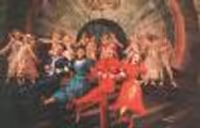Set designs with primarily chairs?
#25Set designs with primarily chairs?
Posted: 12/19/11 at 11:14pmSeanM, thanks for the clarification--that actually sounds familiar, so maybe they said that in the book. Still I wish there was some documentation of them in movement, etc
#26Set designs with primarily chairs?
Posted: 12/20/11 at 8:15am
Twelve Angry Men
Elaine Stritch: At Liberty
The Gin Game
#27Set designs with primarily chairs?
Posted: 12/20/11 at 9:41am
>> "Still I wish there was some documentation of them in movement"
You and me both, good sir. Having had the pleasure of seeing a number of his designs onstage, I gotta tell you, there's nothing short of video that could capture how elegant they were. And the well-known fact that Sondheim wrote the first act finale of NIGHT MUSIC around, among other things, the speed at which those panels moved, just makes that particular moment of theatre so much more awesome, a scene in which *everything* works together to produce something of genius that *does* dance across the stage.
#28Set designs with primarily chairs?
Posted: 12/20/11 at 10:18am
^It's true. Seeing those panels slide like a magician's hands from tableau to tableau as "A Weekend in the Country" was building to its climax, then miraculously seeing all six panels part in unison to suddenly reveal Madame Armfeldt's chateau glimmering in the twilight upstage center-- that moment was as exciting and visceral an Act I finale as any I would ever see onstage.
Only Sondheim himself topped it 11 years later with the Act I finale of "Sunday in the Park with George".
#29Set designs with primarily chairs?
Posted: 12/20/11 at 11:18amIf I recall correct, the "Politics, The Art of the Possible" number in EVITA is, in concept, a game of musical chairs.
#30Set designs with primarily chairs?
Posted: 12/20/11 at 12:16pm
A final note about those sliding screens in NIGHT MUSIC:
No computers. All run by hand and a stage manager's watch.
Amazing, huh.
#31Set designs with primarily chairs?
Posted: 12/20/11 at 1:25pmJackie Hoffman's "A Chanukah Carol". 2 chairs.
broadwayguy2
Broadway Legend Joined: 5/18/03
#32Set designs with primarily chairs?
Posted: 12/20/11 at 1:49pm
SeanMartin,
As amazing as the advent of automation and programming has been in revolutionizing the possibilities of scenic design and scenery in motion, NOTHING quite compares to the well rehearsed finesse of the human hand and breathing touch of a person in response to the music. It's one of the reasons that sloppy transitions and crew work tends to drive me nuts - because when precise, it can be breathtaking in a way that a machine can not yet replicate.
#33Set designs with primarily chairs?
Posted: 12/20/11 at 2:02pm
I saw the original Night Music 6 times and I still remember those sliding panels as if I just saw the production yesterday. They were stage magic.
In fact, I remember having an argument in a thread with a poster who claimed that, according to the bootlegs he had heard, the noise from the panels sliding ruined the show, and I said they made no noise to me, according to the 6 times I sat in the audience.
De La Grande Jatte's Flickr Page
3bluenight
Stand-by Joined: 8/10/11
#34Set designs with primarily chairs?
Posted: 12/20/11 at 2:06pm
and (to state the obvious,) it also reinforces the LIVE aspect of the theater. it accentuates the craft/skill/ability involved in running a show. From the Light Board Op, to the Stage Crew, to the fly operators.
If (when) the day comes that we are able to build machines for the quick changes - yes it will be a marvel of achievement, but it will also deny people the ability and experience to do those quick changes (as choreographed dances). That is a loss in my opinion.
#35Set designs with primarily chairs?
Posted: 12/20/11 at 2:45pmThose things were dead silent. They used a brand new kind of caster wheel that totally ensured that. You think Aaronson was nuts about paint, he was even more a maniac about noise.
broadwayguy2
Broadway Legend Joined: 5/18/03
#36Set designs with primarily chairs?
Posted: 12/20/11 at 4:18pmAs he should be. Nothing pulls you out of the illusion quite so click so quickly as banging sets. It is impossible to overstate the impact of Aaronson and the Eckharts on theatrical design. Impossible.
#37Set designs with primarily chairs?
Posted: 12/20/11 at 5:51pm
Yeah, the bunch at the Metropolitan Opera would do well to remember that some time.
Speaking of which: sets with chairs -- THE CONSUL
broadwayguy2
Broadway Legend Joined: 5/18/03
#38Set designs with primarily chairs?
Posted: 12/20/11 at 8:18pmAnother just struck me. David Korins' design for Orange Flower Water in 2005. It was environmental. Thrust stage. Bed at center. 4 chairs, 1 at each corner, and the stadium bench seating for the audience, which was VERY much part of the set.
#39Set designs with primarily chairs?
Posted: 12/21/11 at 1:01amRe the silent sliders in the original Night Music, the Aronson book recounts a tale of horribly NOISY slider panels ruining the show when it was trying out at the Colonial in Boston. Pete Feller, the grand old man of old-school technical supervisors, suggested replacing the overhead metal tracks with WOODEN ones, advocating a technology that went back several centuries. The wooden tracks went in at the load-in to the Shubert in New York and the rest, as they say, is blissfully silent history.
broadwayguy2
Broadway Legend Joined: 5/18/03
#40Set designs with primarily chairs?
Posted: 12/21/11 at 1:11amYou have to love how historical traditions in technology are true and time tested and often times do things that emerging things can only hope.
#41Set designs with primarily chairs?
Posted: 12/21/11 at 6:51am
LOL -- I'd forgotten about the overhead tracks, Charles. Man, I can just imagine what Aaronson (who was known for the kind of temper that comes with being a solitude-inclined artist) said about the metal ones.
My fav story about him is from the book EVERYTHING IS POSSIBLE, in which the author had to get some revised drawings from him for Feller. Aaronson's wife barely opened the door to hand them out, and the author says he could see Boris sitting at his desk in almost complete dsrkness except for a single desk lamp. Shades of national security secrets! LOL
Jon
Broadway Legend Joined: 2/20/04
#42Set designs with primarily chairs?
Posted: 12/21/11 at 11:45am
Aaronson may have been nuts about noise on Broadway, but could not contrlol it once it was out of his hands.
I saw the one of the first regional productions of CONPANY in Chicago, and they purchased the original Broadway set. The elevators were rather squeaky.
#43Set designs with primarily chairs?
Posted: 12/21/11 at 8:17pm
Probably because they werent installed properly. I doubt Feller went out there to supervise. ![]()
Videos






